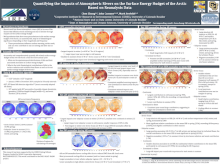Quantifying the Impacts of Atmospheric Rivers on the Surface Energy Budget of the Arctic Based on Reanalysis Data
Chen
Zhang
Cooperative Institute for Research in Environmental Sciences; National Snow and Ice Data Center, University of Colorado Boulder
Poster
Quantifying the Impacts of Atmospheric Rivers on the Surface Energy Budget of the Arctic Based on Reanalysis Data
Atmospheric rivers (ARs) play a crucial role in transporting moisture poleward from lower latitudes and are known to interact with Arctic warming and sea ice decline during the boreal winter. However, their contribution to the Arctic surface surface energy budget (SEB) remains unclear. By analyzing 3-hourly ERA5 reanalysis data and focusing on AR events based on Integrated water vapor transport exceeding the 85th climatological percentile, we explore AR’s seasonal absolute impacts and relative contributions to the mean SEB over a continuous 40-year period spanning from 1980 to 2019—a perspective that has not been adequately explored in existing literature.
The results reveal substantial SEB variation during AR events, characterized by distinct seasonality and pronounced land-sea- sea ice contrast patterns. Over sea ice-covered central Arctic Ocean, ARs have a large positive impact on net SEB, especially in cold seasons, primarily driven by substantial downward longwave radiation (LWD) anomalies, with maximum anomalies exceeding 50 W m-2 over the marginal sea ice zones. However, ARs make their most significant relative contribution to the average net SEB in spring, accounting for at least 45% of the net SEB, surpassing the corresponding AR frequency by more than 34%, potentially initiating the spring sea ice melt.
In subpolar oceans, ARs have a notable impact on SEB during cold seasons, mainly driven by positive turbulent heat flux anomalies. While in summer, strong negative net shortwave anomalies dominate, leading to overall negative net SEB and associated negative effects on the mean SEB. Moreover, ARs generate smaller absolute anomalies but large relative impacts on SEB over continental areas due to the smaller mean SEB. Over Greenland, ARs have a significant impact, contributing to almost six times of the SEB compared to their occurrence frequency, thereby potentially triggering melt events over the Greenland Ice sheet during summer.
Overall, the study helps quantify the role of ARs on SEB, which contributes to the understanding of the Arctic warming and sea ice decline with the ongoing Arctic amplification.
Atmospheric rivers (ARs) play a crucial role in transporting moisture poleward from lower latitudes and are known to interact with Arctic warming and sea ice decline during the boreal winter. However, their contribution to the Arctic surface surface energy budget (SEB) remains unclear. By analyzing 3-hourly ERA5 reanalysis data and focusing on AR events based on Integrated water vapor transport exceeding the 85th climatological percentile, we explore AR’s seasonal absolute impacts and relative contributions to the mean SEB over a continuous 40-year period spanning from 1980 to 2019—a perspective that has not been adequately explored in existing literature.
The results reveal substantial SEB variation during AR events, characterized by distinct seasonality and pronounced land-sea- sea ice contrast patterns. Over sea ice-covered central Arctic Ocean, ARs have a large positive impact on net SEB, especially in cold seasons, primarily driven by substantial downward longwave radiation (LWD) anomalies, with maximum anomalies exceeding 50 W m-2 over the marginal sea ice zones. However, ARs make their most significant relative contribution to the average net SEB in spring, accounting for at least 45% of the net SEB, surpassing the corresponding AR frequency by more than 34%, potentially initiating the spring sea ice melt.
In subpolar oceans, ARs have a notable impact on SEB during cold seasons, mainly driven by positive turbulent heat flux anomalies. While in summer, strong negative net shortwave anomalies dominate, leading to overall negative net SEB and associated negative effects on the mean SEB. Moreover, ARs generate smaller absolute anomalies but large relative impacts on SEB over continental areas due to the smaller mean SEB. Over Greenland, ARs have a significant impact, contributing to almost six times of the SEB compared to their occurrence frequency, thereby potentially triggering melt events over the Greenland Ice sheet during summer.
Overall, the study helps quantify the role of ARs on SEB, which contributes to the understanding of the Arctic warming and sea ice decline with the ongoing Arctic amplification.

zhang-chen-polar-poster.pdf
(5.41 MB)
